One of the best decisions I’ve made since becoming a mother is deciding to co-sleep with my daughter Lily. I previously wrote a post about what led me to make the choice to co-sleep and all the benefits it’s offered me. I thought today I could delve a little deeper into co-sleeping safely. I know many people are very concerned about the safety of co-sleeping, specifically bed-sharing.
Luckily, there are many things parents can do to ensure a safe and happy sleep environment if they want to cosleep with their baby.
I am not an expert on the subject of safe co-sleeping by any means. Still, I have successfully shared a bed with my 17-month-old daughter since the first night I brought her home and have learned a few things along the way that might be helpful to new parents.
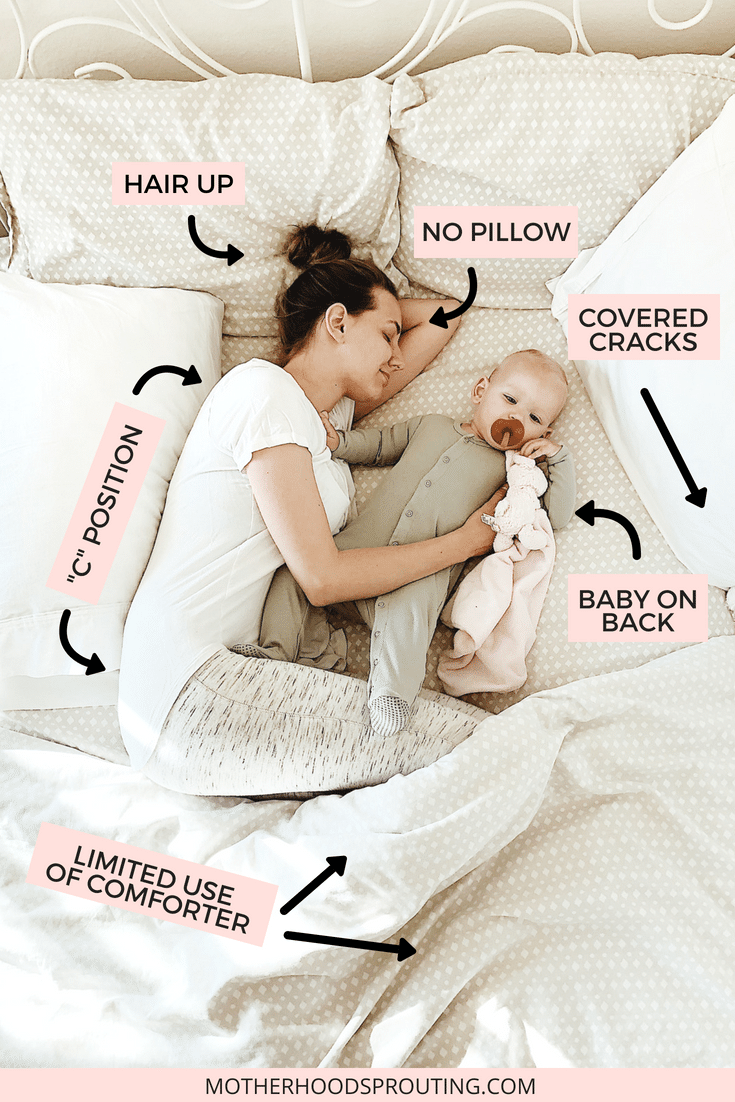
1. Breastfeed
One of the best ways to ensure a safe co-sleeping experience is to breastfeed your baby.
Actually, for the sake of this post, I am going to assume you are breastfeeding your child. This is because my daughter has always been breastfed and I can only speak about my co-sleeping experience from the perspective of a breastfeeding mama and baby.
Here is why breastfeeding may be safer for bed-sharing parents than those with formula-fed babies (according to Infant Sleep Information Source):
- Bed-sharing babies of breastfeeding mothers appear to avoid the presumed hazards of sleeping in adult beds (suffocation, overlaying, wedging, etc.)
- Breastfeeding mothers tend to instinctively place their babies in safer sleeping positions on the bed. For example, below the pillows in line with the mother’s breast and flat on the mattress.
- Breastfeeding mothers and babies tend to naturally sleep facing each other which is known as a “protective” position.
- Breastfeeding mothers and babies wake more often and more easily during the night and those waking moments tend to be synchronized; something not seen with formula-fed babies.
Basically, breastfeeding causes a mother and her child to be more connected when sleeping. They become keenly attuned to one another and because of that safe co-sleeping with a newborn is more of a possibility.
There’s even a new term circulating that puts a label specifically on a mother who breastfeeds and bed shares: Breast-sleeping. Because co-sleeping is actually a broad term used for having a child sleep in the same room as the parent, breast-sleeping more accurately describes a mother who bedshares while breastfeeding.
Special note: If you are for some reason not able to breastfeed your child, please do not be discouraged. If you are diligent in following all the tips below there should be no reason you can’t happily and safely co-sleep with your baby. Trust your instincts, listen to your gut, and follow your heart. You will know what is best for you and your baby. 🙂
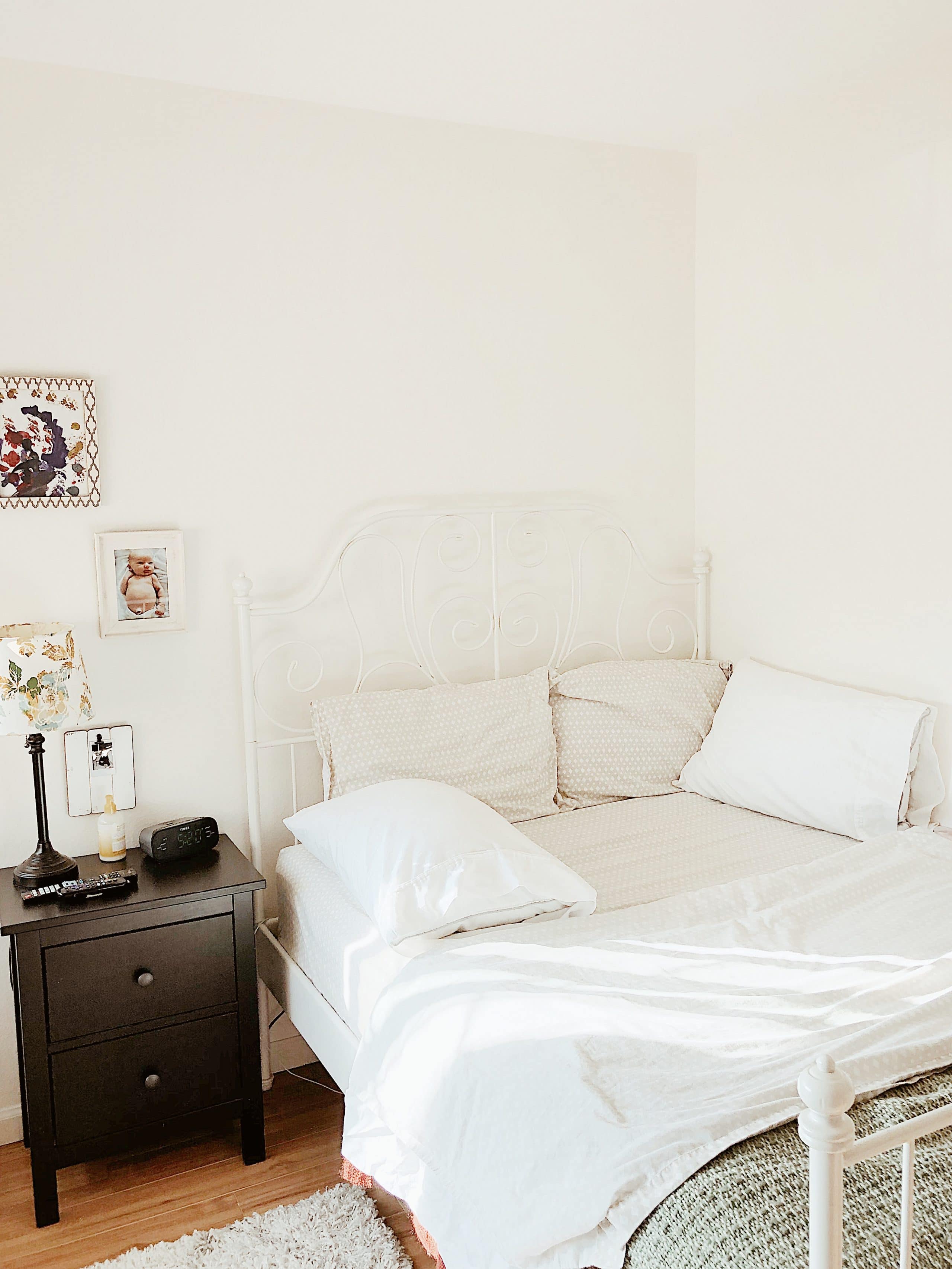
2. Go pillow free
I know a lot of people may not like this, but no one ever said parenthood comes without sacrifice.
My next tip is to go pillow free! I have officially learned how to sleep without a pillow and instead I’ll just sleep on my arm.
I started doing this when Lily was around 3 months old, maybe sooner. Even when she was not able to roll over, she would somehow find a way to bury her face in my pillow. It really freaked me out, to say the least. I would rather go pillow free than worry that Lily is going to get her face stuck in my pillow while I’m sleeping.
Now I just place all my pillows around us leaning against the wall and my headboard. It gives a sense of comfort and protection, yet we actually sleep away from them closer to the middle of the bed.
This is not going to be everyone’s cup of tea, but this is one thing that has really worked for me in making a safe environment while bed-sharing.
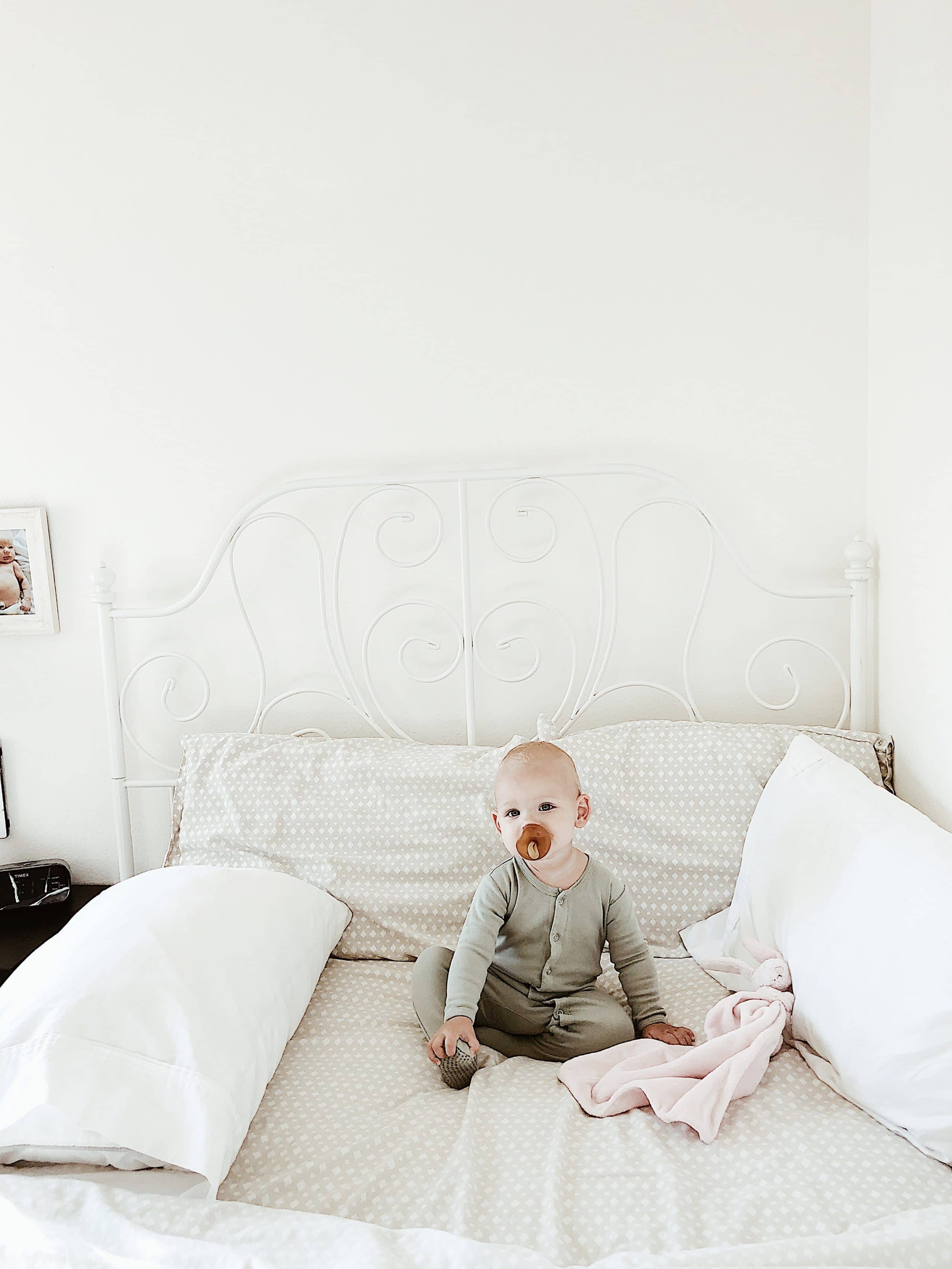
3. Limit the use of a comforter
This is where living in southern California comes in handy. Comforters and blankets are rarely a necessity. We all know that babies should not have any comforters or blankets of any kind around them while they are sleeping. This is still true when bed-sharing.
There is really no trick for this one. You can’t use a comforter or blanket! Okay, you can technically use one as long as it only covers you and it’s not too heavy or thick. You need to make sure that on the off chance your baby gets covered with it sometime in the night, it’s not too heavy for them to move or kick-off.
When I do use a comforter I only pull it up over my legs and never near my midsection where my baby is usually nestled. Once again, this might be a bit of a sacrifice for parents. Still, if you want to bed share and do it safely, it’s just one of the things you have to do.
If you are worried that your baby will be cold, don’t be. It is actually more important that you don’t overheat your baby while they sleep.
My daughter hates having any kind of comforter on her so this was never an issue for us. She naturally gets warmer when she sleeps (I think most babies do!). All you have to do is make sure your baby is dressed in the appropriate pajamas for the season and they should be good to go.
If you live in colder climates or feel like your baby might get cold at the night then you can always use a sleep sack. Lily never used one but I know most parents do as it’s a safe way to keep your baby warm in the night without using a loose blanket.

4. Cover or eliminate cracks around the bed
My next tip for safe co-sleeping is to cover or eliminate any and all cracks around your bed. There should not be any small or large spaces where your baby could get lodged or stuck.
This is more of a concern after your baby learns to roll over on their own. Still, no matter how old your baby is or how advanced their body control may be, there should never be any cracks or spaces around your bed that they could fall into or get stuck in.
This is even more of a concern if you have your bed pushed against the wall as I do. I have my bed pushed against the wall for two reasons. One, it saves space in the rest of my small room. Two, it eliminates one side where my daughter could roll off of the bed. I like sleeping on the open end of the bed and putting Lily on the inside by the wall, so then there’s no area for her to roll off.
There is no way to push a bed flush against a wall without leaving a space between the bed and the wall. To make sure your baby doesn’t roll over and get stuck in the crack you can roll up a blanket to fill the space. I used to shove a long blanket in the crack so it closed up the hole and after I put my comforter over the top you couldn’t even tell it was there.

5. Sleep in a “C” position
One of the things I have done since I started co-sleeping with my daughter is sleep in a “C” position. This basically means curling your body around your baby in a “C” or half-circle shape.
I have NEVER slept with my back facing my child while co-sleeping. I believe doing that disconnects you from your baby, makes it so you can’t see them, and also makes rolling back onto them a greater possibility.
C curl co-sleeping allows you to feel and see your baby easily. Your body also acts as a protective barrier. If you are wrapped around your baby this way you are more likely to feel them move and being so close to them allows you to wake up more easily when they need you.
Sleeping in this position is also the most comforting way to sleep for your baby. Think of the c curl co sleeping position like your body acting like a baby lounger. Being close to you, hearing and feeling your breathing, and feeling your touch is going to allow your baby to feel safe and comfortable enough to have a good night’s sleep.
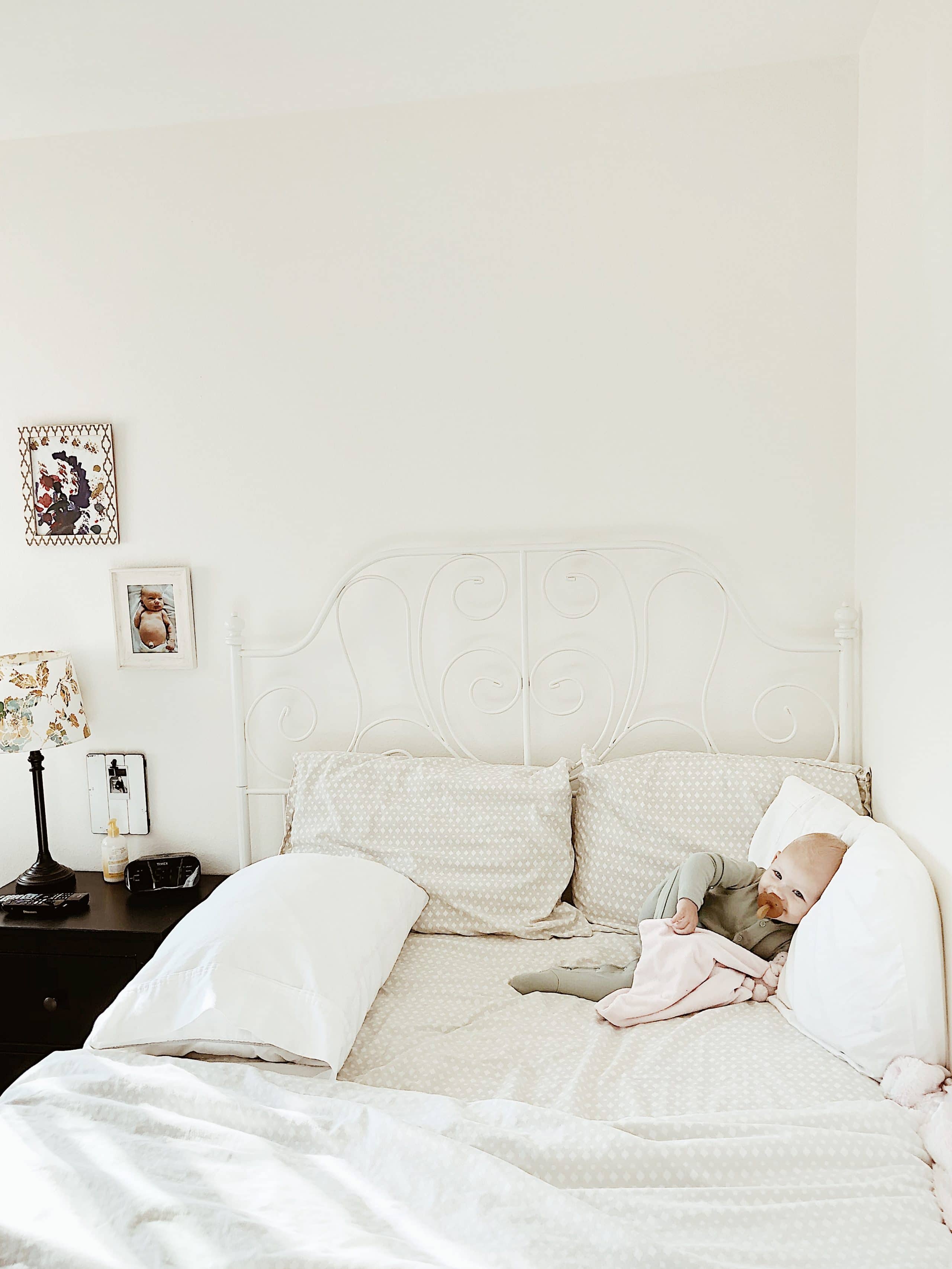
6. Put your baby on their back
Anytime your baby is sleeping they should be sleeping on their back, whether they are bed-sharing with you or in a crib or bassinet. The only time is it safe to let your baby sleep on their stomach is if they are sleeping on your chest and you are awake.
Although many pediatricians and authorities on safe sleeping regulations do not agree with co-sleeping/ bed-sharing, there is one thing we can all agree on: Babies should always sleep on their backs!
Most authorities say that once babies can roll over on their own it is okay for them to sleep on their stomachs if they get into that position on their own. However, I never let Lily sleep on her stomach at night. If she rolled over on her own during a daytime nap, then I would let her stay there because I could watch over her. But if I felt her roll over while sleeping in the middle of the night, I always rolled her back over before I fell asleep again.

7. Keep your hair up at night
Another huge safety precaution to take while co-sleeping is for mothers to always have their hair tied up securely in a bun. This goes for fathers with long hair too!
Having your hair down while you sleep with your baby is dangerous. This is because your hair can get wrapped around your baby’s neck or face and suffocate them. This is especially important in regard to younger babies who don’t have the gross motor skills to clear hazards away from their faces on their own.
I never liked sleeping with my hair down anyway because it would always get in my face. So this was easy for me to do. Once again, some parents might see this as a sacrifice. If you feel that way then maybe co-sleeping isn’t for you. And that’s okay too!
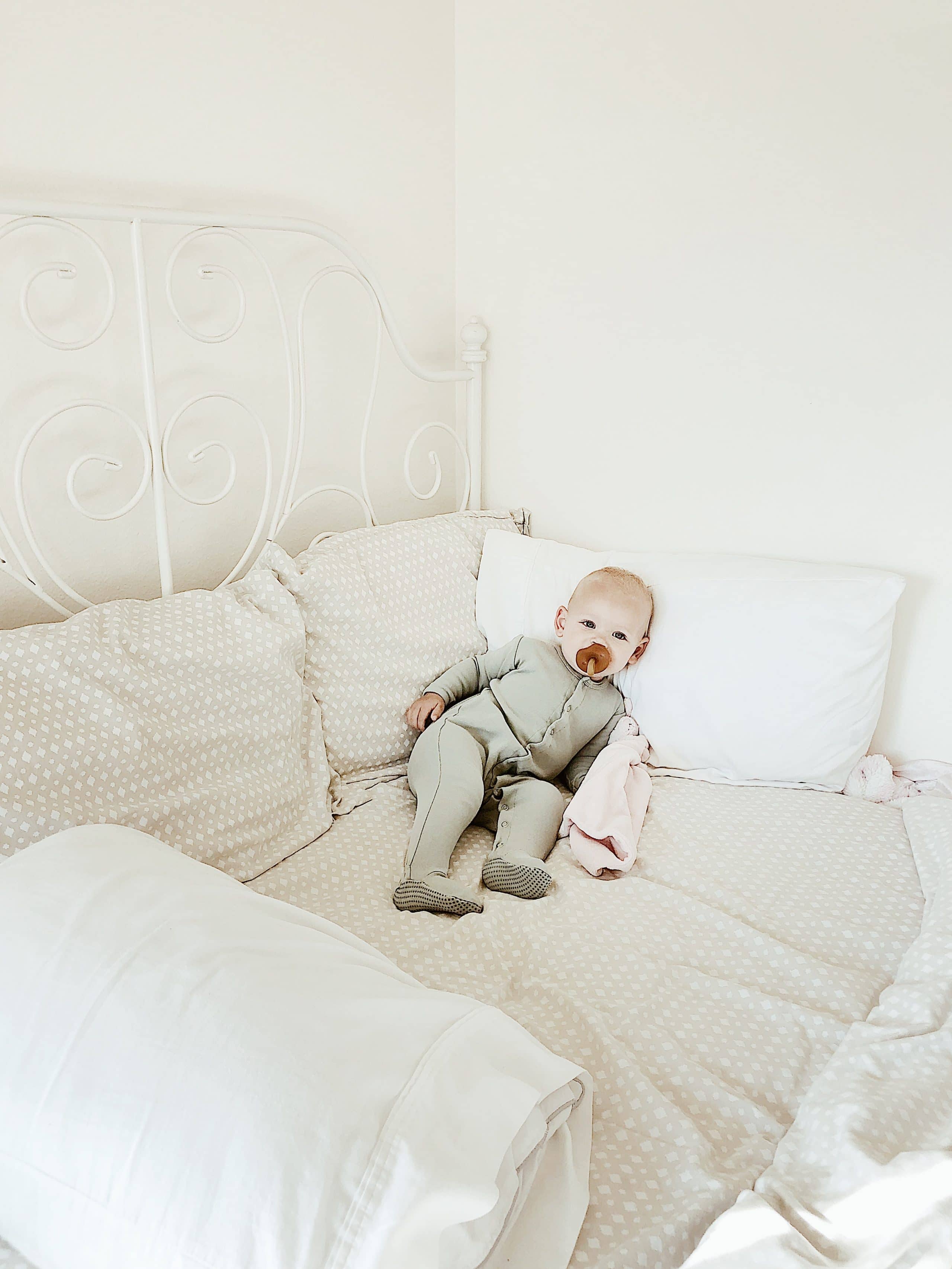
8. Always trust yourself
Co-sleeping and especially bed-sharing is a pretty hot topic. As a matter of fact, up until recently, it was considered completely unsafe and strongly discouraged.
Actually, most people still feel that way; however, more and more people are coming out as co-sleeping parents and more articles and studies are showing that if done safely, co-sleeping can actually be very beneficial for both mothers and their babies.
My last piece of advice for co-sleeping safely is to TRUST YOURSELF.
If for any reason it makes you feel uncomfortable, don’t do it! While I will always encourage mothers to sleep in the same room as their babies for the first year, you do not have to bed-share if it doesn’t feel right to you. You can put a co-sleeper or bassinet next to your bed or even put a crib in your room. There are so many options for being near your baby at night if bed-sharing is not your cup of tea.
If you decide bed-sharing is something you want to do and something you feel passionate about, then do it! And don’t forget to trust yourself!
The bond between a mother and her child is such a magical thing. Our bodies and minds are capable of incredible things and sometimes we just need to trust that they will know what to do.
I used to be such a restless and very mobile sleeper. Yet, since the very first night I brought Lily into my bed I no longer move while I sleep. It is seriously the weirdest thing. I fall asleep and wake up in the same position.
Somehow whenever Lily needs to nurse, I will magically wake up. She has never cried when she was hungry during the night. When she was younger, I would wake up and she would only be squishing her face, rooting around, and fussing a bit. How I knew to wake up without her crying I will never know. Now that she’s older, I still weirdly wake up at the same time she is hungry without her having to cry.
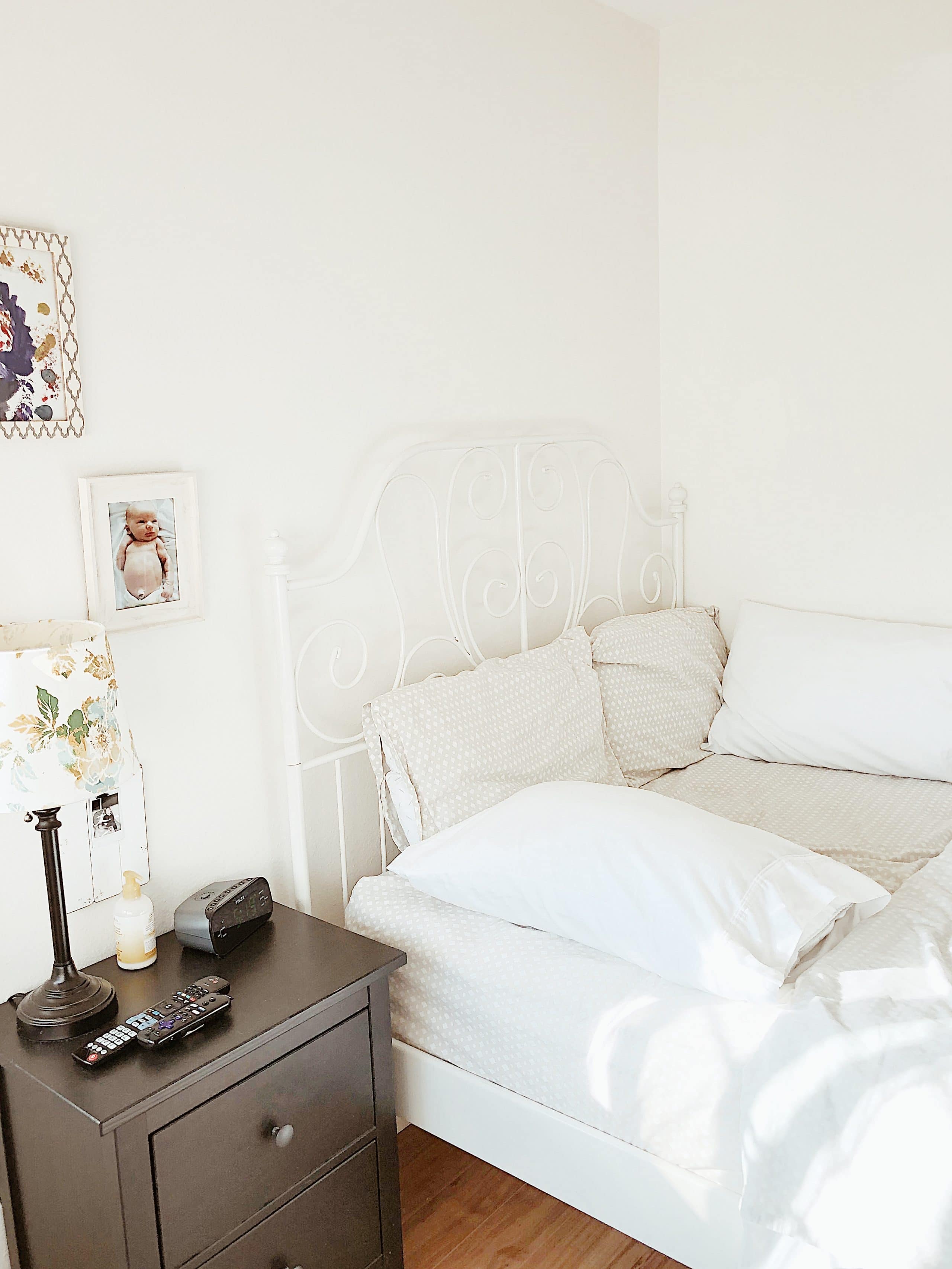
In Conclusion
Co-sleeping is not for everyone and that is completely fine. Everyone parents their children differently and sleeping arrangments are just one way we all differ.
However, if co-sleeping is something you’re passionate about but are worried you will be putting your child in danger, just know that there are so many steps you can take to make sure you are creating a safe sleep environment for your baby.
Co-sleeping requires a lot of sacrifices and changes that need to be made by the parents in order to make co-sleeping safe and successful. If you are not willing to make those changes, then you probably shouldn’t be co-sleeping.
I have made many sacrifices and changes to my sleep environment, patterns, and routines to make sure my daughter is as safe as possible. I have to say that for me those “sacrifices” don’t really feel like sacrifices anymore. For me, they are far outweighed by the benefits.
Nothing beats falling asleep next to my baby girl, getting those sweet cuddles during the night, and waking up to her beautiful smiling face!


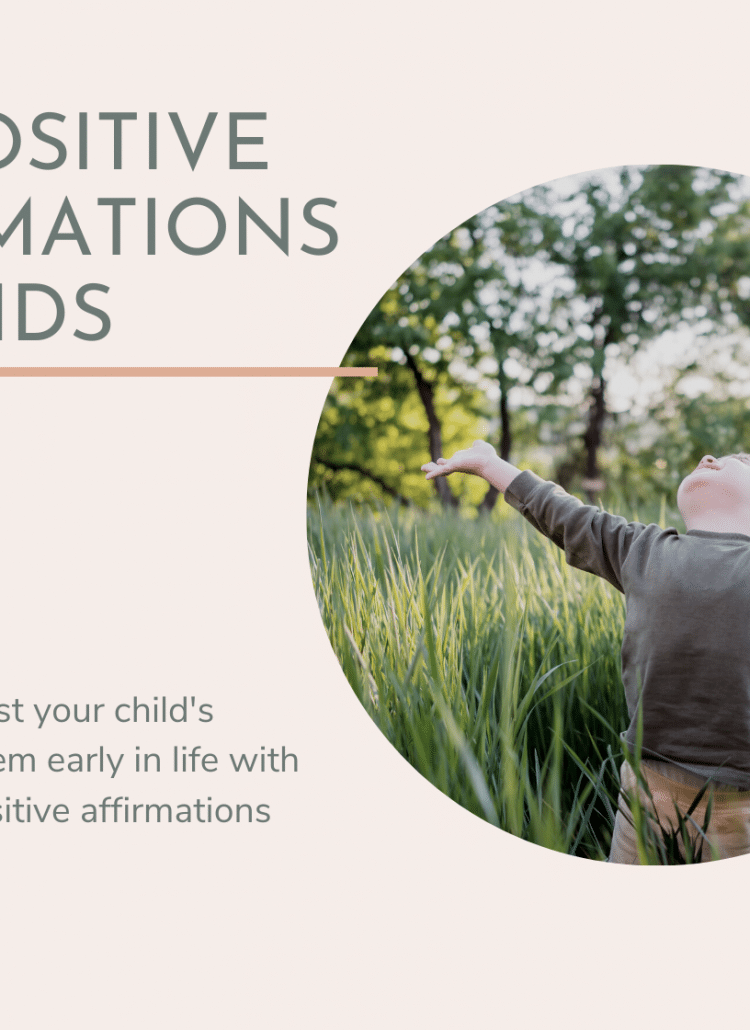
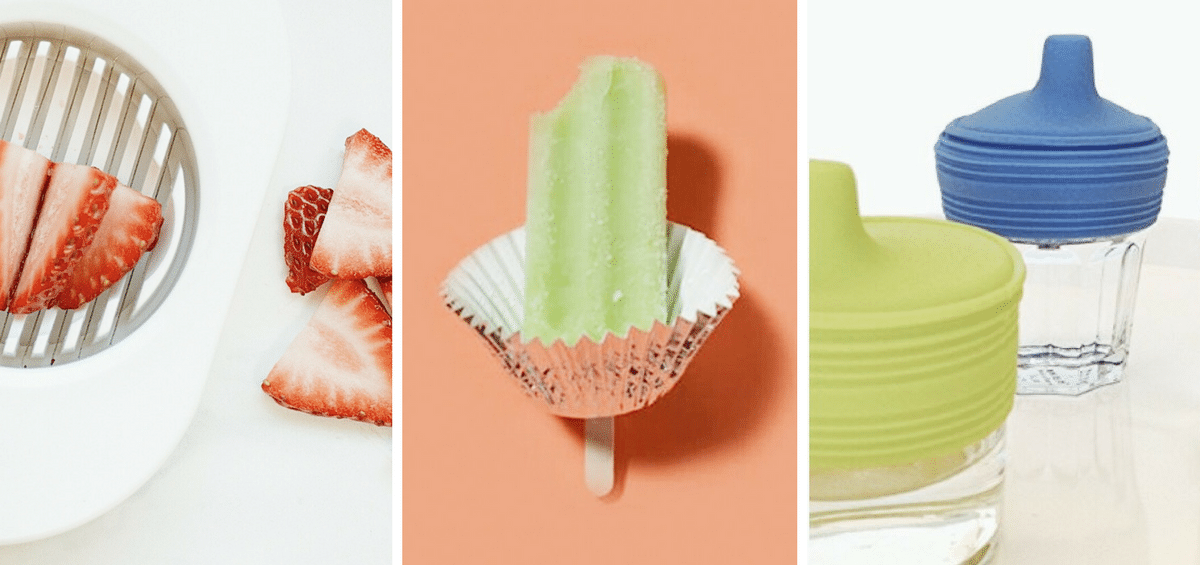
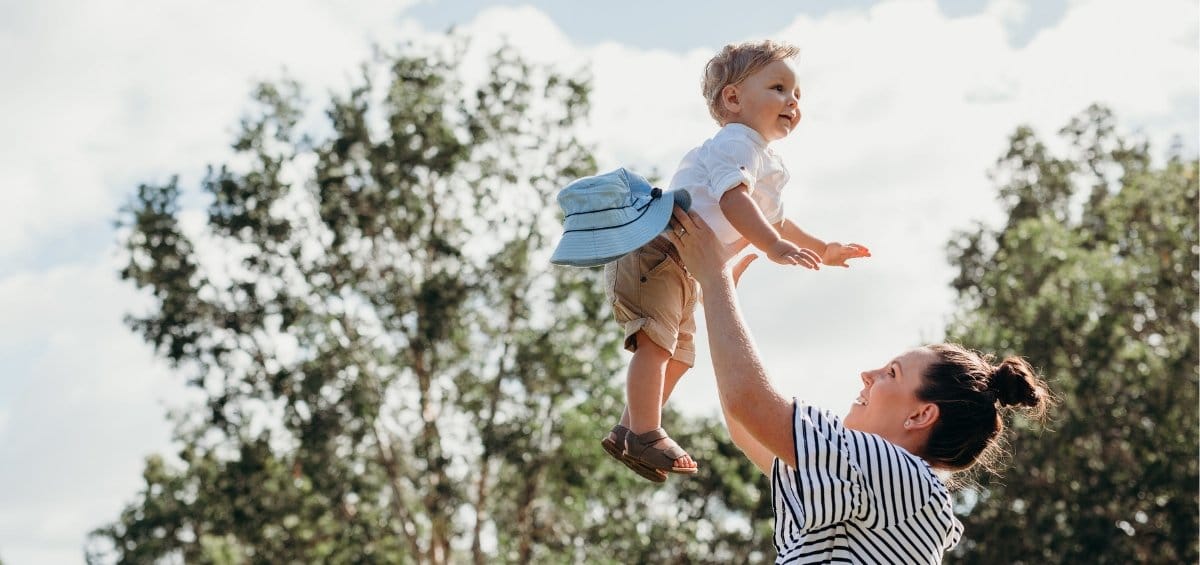
I appreciate you taking the time to compile your tips on co-sleeping safely! I do have to be honest here, I’m a little hurt by #1. None of my babies latched even after months of work with a board certified lactation consultant. Although my baby had a blend of pumped breastmilk and formula, I’m no less close with my child or less aware about my child being awake in the night.
Although you’ve mentioned you can only speak from being a breastfeeding mama, perhaps you could be a bit sensitive to those who can’t breastfeed but are trying to co-sleep. Not hating on your work here, I still found value in your article. I wanted to share another perspective so you can encourage all moms who are trying to co-sleep, not just the amazing breastfeeding ones. 🙂
Hi, Lisa!
First, I want to say thank you so much for taking the time to share your opinion. It really does help me when writing posts moving forward. I honestly really appreciate it. Second, I want to apologize. I know how hard breastfeeding is and it was never my intention to diminish the relationship non-breastfeeding mothers have with their children. So if you felt like I did that, I’m sorry. Third, the reason I added that was because of all the research I did prior to writing the post. However, research aside, I have always believed that mothers know what’s best for their children better than any studies or statistics. I am very passionate about co-sleeping, so if co-sleeping is something you want to do – breastfeeding or not – I’ll be over here rooting you on!
Have a beautiful day!
Sydney
Ps. I added a special note in that section to hopefully not hurt any other mamas who stumble across this post in the future!
Thanks for the article. I am bedsharing my 5 week old and am curious if you had any tips if you have a partner also sleeping in the same bed
Love this! Also, I think something we forget in the West is that there are so many experiences outside of our own. In most cultures outside of the West, bed sharing is very common. Knowing that gives me reassurance as well – there are mothers and babies all over the world doing just fine sharing sleeping spaces.
I found this to be a very interesting read! I am not a fan of co-sleeping myself but know a lot of mothers want to do it and I think these are some great safety tips for anyone who does choose to co-sleep. I am curious though about how challenging it is to transition a baby to sleep in their own room after co-sleeping for a year or more? That sounds like it would be extremely hard especially since babies tend to start experiencing separation anxiety for the first time around 9/10 months old. We had our daughter in our room for the first 6 months. After 6 months the risk of SIDS is very low and we felt that would be the best time to start the transition before she learned about separation. She has been successfully sleeping in her own room since then (she’s almost a year old now) without any issues and mom and dad have their own bed (and pillows!) to sleep on 🙂
We got a co-sleeper little mini-crib which worked perfectly until our daughter was one.